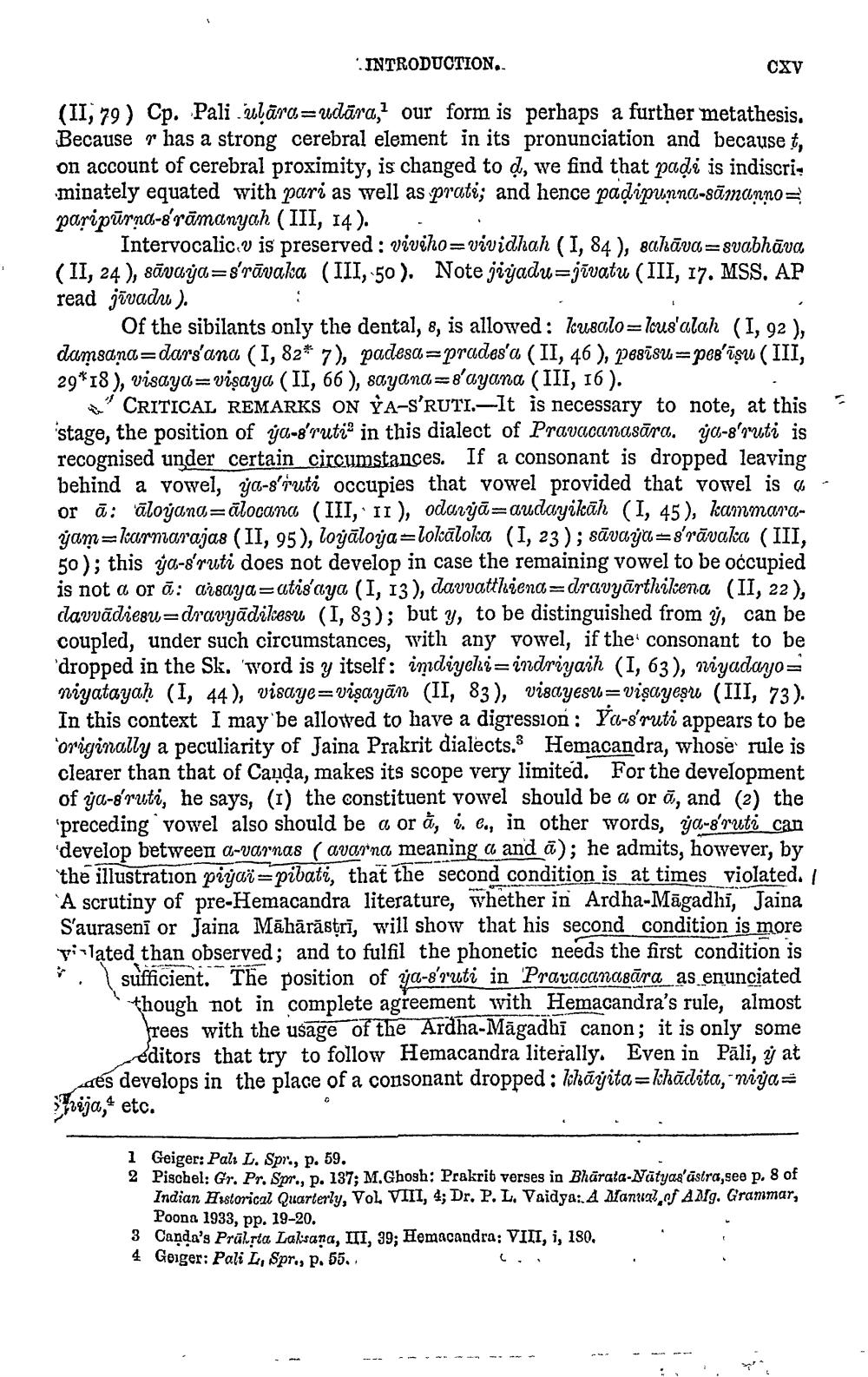________________
INTRODUCTION.
Сху
(II, 79) Cp. Pali ulārd;=udāra," our form is perhaps a further metathesis. Because w has a strong cerebral element in its pronunciation and because t, on account of cerebral proximity, is changed to d, we find that padi is indiscri. minately equated with pari as well as prati; and hence padipunna-sāmanno paripūrna-o'rāmanyah (III, 14). .
Intervocalic v is preserved : viviho=vividhah (1,84), sahāva=svabhāva, (II, 24), sāvaya=s'rāvaka (III, 50 ). Note jiyadu=jīvatu (III, 17. MSS. AP read jīvadri).
Of the sibilants only the dental, 8, is allowed: kusalo=Icus'alah (1, 92), damsana=dars'ana (I, 82* 7), padesa=prades'a (II, 46 ), pesīsu=pes’īşu ( III, 29*18), visaya=vişaya (II, 66 ), sayand=s'ayana (III, 16).
F CRITICAL REMARKS ON ỦA-S'RUTI.—It is necessary to note, at this stage, the position of ýa-s'ruti' in this dialect of Pravacanasāra. yu-o'ruti is recognised under certain circumstances. If a consonant is dropped leaving behind a vowel, ja-s'ruti occupies that vowel provided that vowel is - or ā: ūloyang=ālocana (III, II ), odarýā=audayikāh (I, 45), kammarajam=karmarajas (II, 95), lojāloya=lokāloka (I, 23); sūvaya=s'rāvaka (III, 50 ); this ya-o'ruti does not develop in case the remaining vowel to be occupied is not a or ā: arsayaratis'aya (I, 13), davvatthiena=dravyārthikena (II, 22 ), davvādiegu=dravyādikesu (I, 83); but y, to be distinguished from y, can be coupled, under such circumstances, with any vowel, if the consonant to be 'dropped in the Sk. 'word is y itself: indiyeli=indriyaih (1, 63), riyadayo= niyatayah (I, 44), visaye=vişayān (II, 83), visayesu=vişayezu (III, 73). In this context I may be allowed to have a digression : Yo-sruti appears to be originally a peculiarity of Jaina Prakrit dialects. Hemacandra, whose rule is clearer than that of Canda, makes its scope very limited. For the development of ya-ruti, he says, (I) the constituent vowel should be a or ā, and (2) the preceding vowel also should be a or à, . l., in other words, ya-g'ruti_can develop between a-varnas ( avarena meaning a and a); he admits, however, by the illustration pijaï=pibati, that the second condition is at times violated. I A scrutiny of pre-Hemacandra literature, whether in Ardha-Māgadhi, Jaina S'auraseni or Jaina Māhārāstrī, will show that his second condition is more yilated than observed; and to fulfil the phonetic needs the first condition is
sufficient. The position of ja-'q'uti in Praracanasāra as enunciated though not in complete agreement with Hemacandra's rule, almost
rees with the usage of the Ardha-Māgadhī canon; it is only some
editors that try to follow Hemacandra literally. Even in Pāli, y at des develops in the place of a consonant dropped: Ichāyita="hādita, "niya= Strija, etc.
1 Geiger: Pali L. Spr., p. 59. 2 Pischel: Gr. Pr. Spr., p. 137; M.Ghosh: Prakrib verses in Bhārata-Nātyas'āstra,see p. 8 of
Indian Historical Quarterly, Vol. VIII, 4; Dr. P. L. Vaidya: A Manual of Ang. Grammar,
Poona 1933, pp. 19-20. 3 Canda's Prālrta Laksana, III, 39; Hemacandra: VIII, i, 180, 4 Geiger: Pali L, Spr., p. 55.




